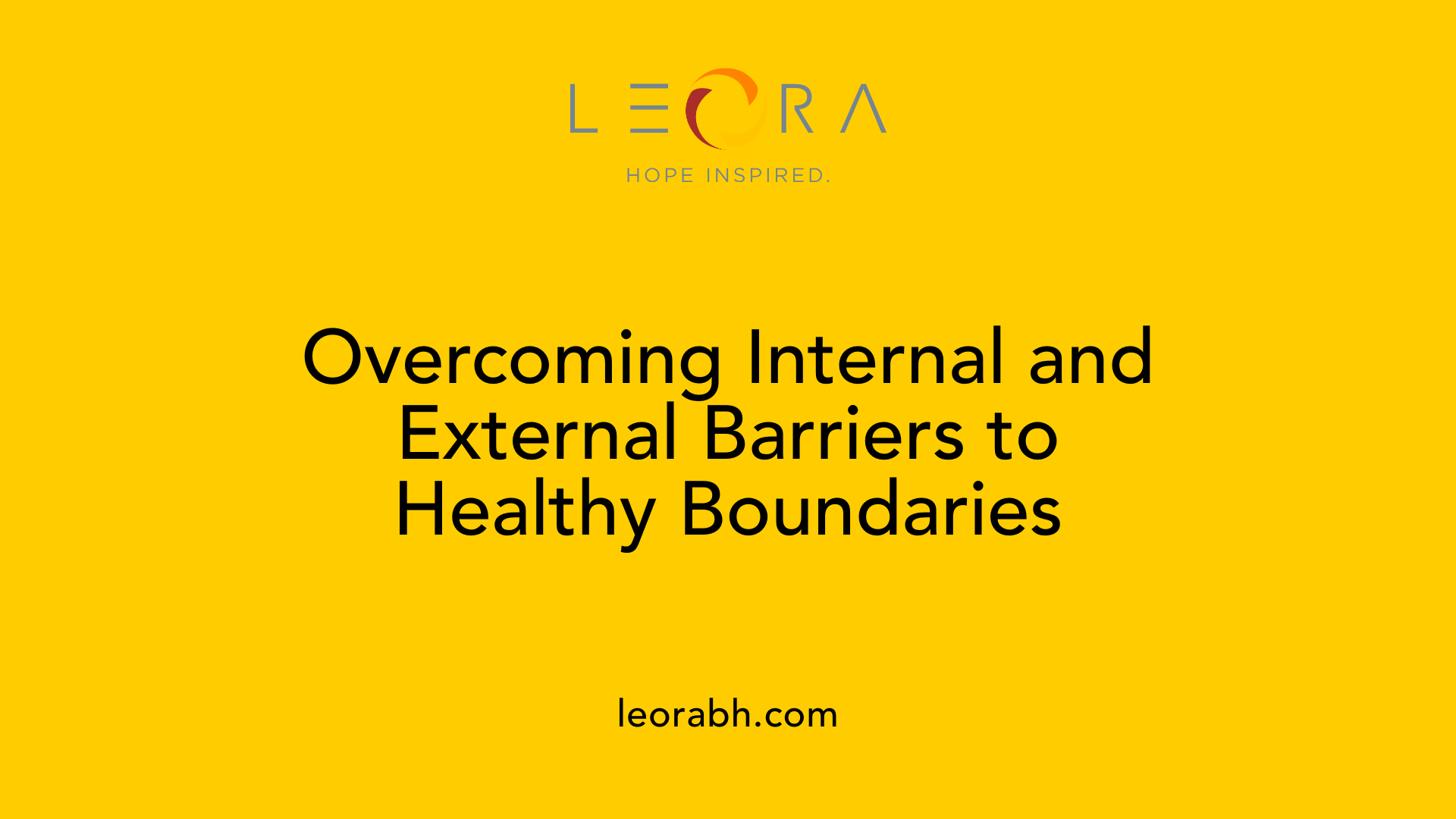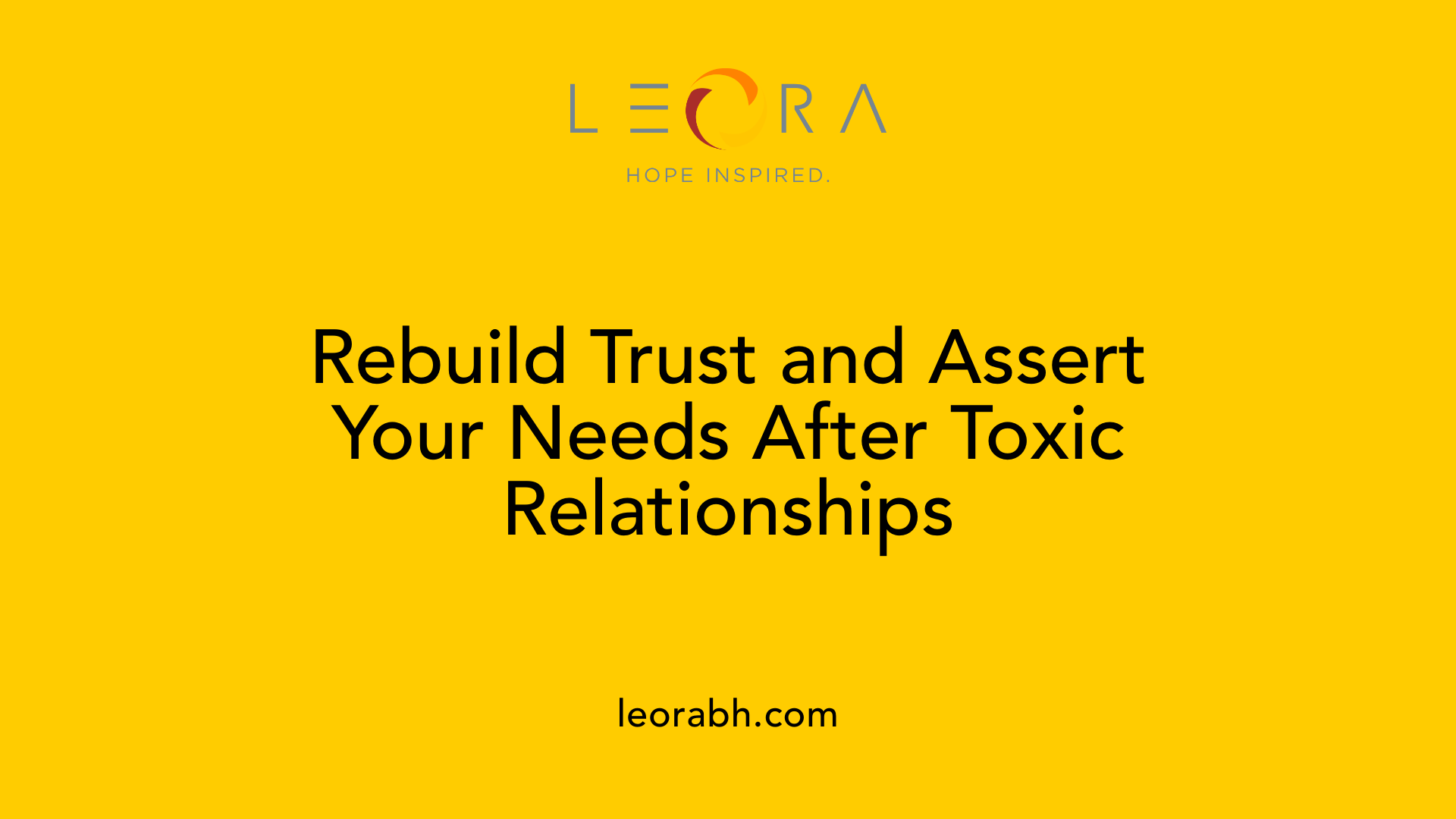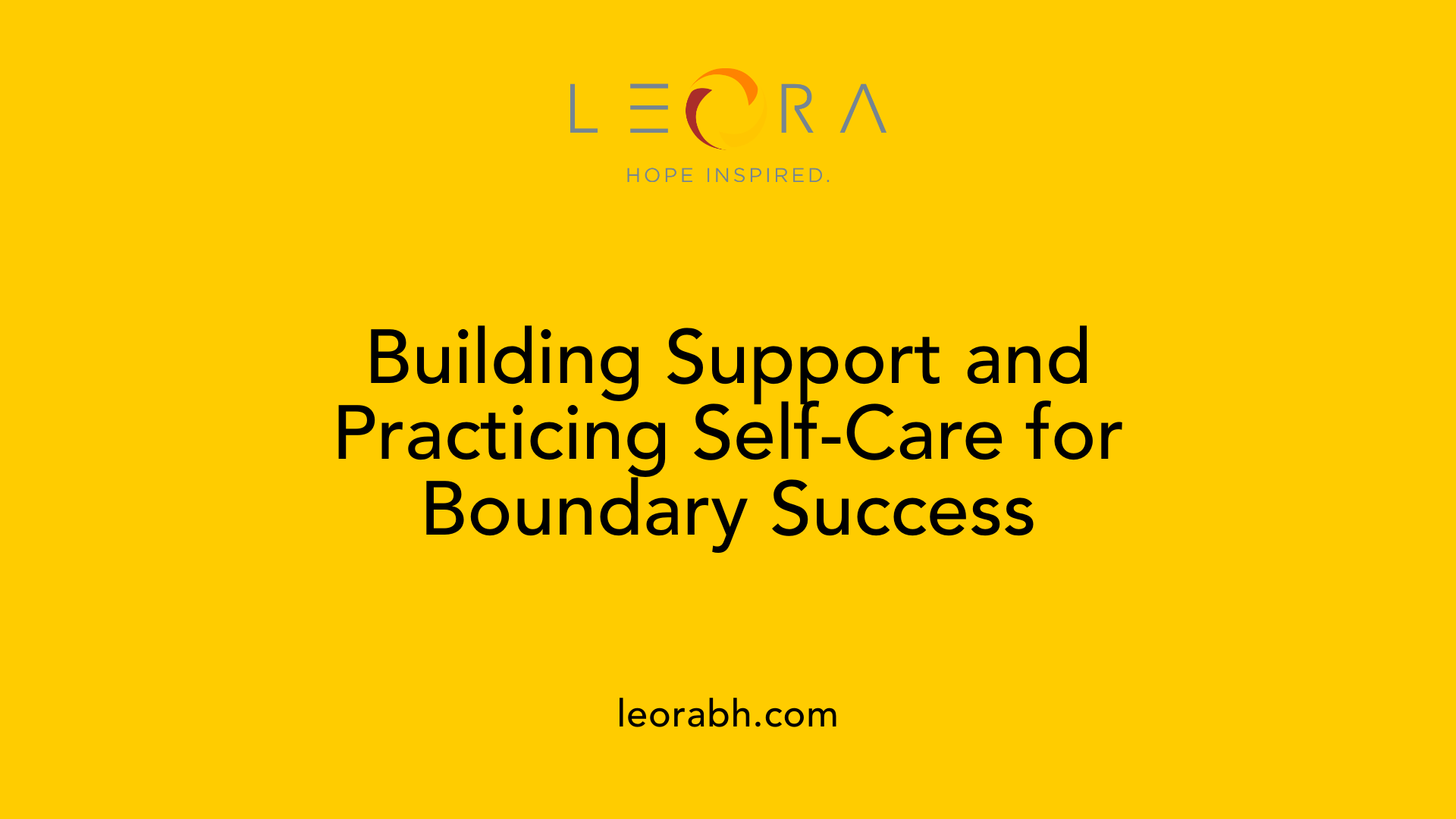How to maintain boundaries with toxic relationships post-treatment
Reclaiming Control: Strategies for Healthy Boundaries After Toxic Relationships
Understanding the Importance of Boundaries Post-Toxicity
Recovery from a toxic relationship is a vital step toward personal healing and building healthier, more fulfilling connections. Establishing and maintaining boundaries plays a central role in this process. Boundaries act as protective barriers that safeguard emotional and mental well-being, helping individuals regain confidence, trust, and control over their lives. However, the journey toward effective boundary-setting comes with challenges, often rooted in internal fears, societal influences, and past experiences. Recognizing these hurdles is the first step to overcoming them and fostering a new foundation for respectful and balanced relationships.
Identifying the Challenges in Boundary-Setting

What is the primary obstacle to setting healthy boundaries?
One of the main hurdles in establishing healthy boundaries stems from internal fears. Many individuals grapple with fears of rejection, conflict, or negative repercussions if they speak up for themselves. These emotional barriers often lead to hesitation, making it difficult to assert needs and limits.
External influences also play a significant role. Workplace cultures that normalize long working hours or constant availability can pressure individuals into sacrificing personal boundaries. Societal norms that promote people-pleasing, acceptance, and avoiding conflict further complicate boundary-setting efforts.
Additionally, confusion around expectations and unclear organizational or social norms muddle the process. When roles and boundaries are not explicitly defined, it becomes challenging to recognize when and how to establish limits.
Low self-esteem, self-doubt, and perfectionism serve as emotional obstacles that diminish confidence in asserting boundaries. These feelings often cause individuals to second-guess their needs or fear being perceived as difficult.
Overcoming these challenges involves deliberate self-awareness and skill development. Recognizing internal fears, challenging limiting beliefs, and practicing clear communication help pave the way for healthier interactions. Building confidence and understanding one's worth encourages setting boundaries that protect well-being and foster respect.
In summary, internal fears, societal pressures, lack of clarity, and emotional self-doubts are prominent barriers. Addressing them requires ongoing self-reflection, supportive environments, and empowering strategies to foster better boundary practices.
Practical Strategies for Effective Boundary-Setting Post-Treatment

How can I set and maintain healthy boundaries after experiencing a toxic relationship?
After recovering from a toxic relationship, establishing healthy boundaries becomes vital for healing and fostering trust. Begin by developing a deep understanding of your personal needs, limits, and values. This self-awareness helps in deciding what behaviors you will accept and what crosses your limits.
Communicate these boundaries clearly and assertively. Use ‘I’ statements to express your feelings and boundaries without blaming, such as, 'I am not comfortable discussing this topic.' Enforce your boundaries consistently; gentle reminders or calmly reiterating your limits reinforce your commitment to self-respect.
Recognize that boundary setting may initially feel uncomfortable or challenging. Supporting this process with regular self-care activities—like journaling, engaging in therapy, or joining support groups—can boost your confidence and emotional resilience.
Maintaining firm boundaries helps you rebuild trust in yourself, restores your sense of safety, and encourages the development of healthier, more respectful relationships.
The Role of Support Systems and Self-Care in Boundary Maintenance

Building a strong support network of friends, family, and professionals
A robust support system is vital for those recovering from toxic relationships. Trusted friends and family members can provide emotional validation and practical advice, making it easier to identify and enforce healthy boundaries. Mental health professionals, such as therapists, support groups, and hotlines, offer expert guidance, reassurance, and a safe space to process complex feelings.
Support networks also act as external anchors, helping individuals maintain their boundaries when internal resolve wavers. They offer an outside perspective that can counteract manipulation or gaslighting tactics often seen in toxic dynamics. Engaging with a consistent support group creates a sense of community and accountability—crucial elements for long-term healing.
Having these systems in place reduces feelings of isolation, enhances resilience, and promotes ongoing growth. These relationships serve as reminders that recovery is possible and that healthier relationships are within reach.
Practicing self-care activities like journaling, meditation, and physical movement
Self-care routines are essential tools for reinforcing boundaries and supporting emotional health. Journaling, for example, allows individuals to reflect on their feelings and recognize moments when boundaries are crossed. It creates a record of experiences, helping to identify patterns and triggers, and solidifies self-awareness.
Meditation and mindfulness exercises cultivate a calm, present-focused mindset. They help individuals tune into their internal states, notice emotional responses, and respond thoughtfully rather than react impulsively. This calmness enhances confidence when communicating boundaries and managing difficult interactions.
Physical movement—such as walking, yoga, or other forms of exercise—reduces stress, improves mood, and fosters a connection to one's body, reinforcing a sense of safety and self-control. Consistent engagement in these activities nurtures resilience and recharges emotional energy, making it easier to uphold boundaries during challenging situations.
Seeking therapy and joining support groups for guidance and validation
Therapy provides a safe environment to explore the impact of toxic relationships and develop effective boundary-setting skills. Techniques like emotionally focused couples therapy help strengthen emotional connection and communication, essential for rebuilding trust.
Therapists facilitate understanding of red flags and teach coping strategies, empowering individuals to recognize unhealthy patterns early. They guide in healing emotional scars, fostering self-esteem, and making informed decisions about continuing or ending relationships.
Support groups, whether in person or online, connect individuals facing similar challenges. Sharing experiences in such spaces validates feelings and provides new perspectives. These groups can also offer practical advice on boundary enforcement and strategies to avoid falling into past toxicity.
Recognizing the importance of external support in recovery and boundary enforcement
External support is crucial because toxic relationships often involve manipulation and isolation efforts. External perspectives help individuals see beyond the distorted narratives imposed by manipulators.
Support from friends, family, and professionals reinforces self-trust and combats feelings of doubt or guilt. It reminds individuals of their worth and right to personal limits. External validation strengthens confidence to enforce boundaries consistently.
Moreover, consistent external input helps maintain accountability, making it easier to stick to new standards. It provides reassurance during setbacks and encourages persistence in establishing healthier dynamics.
Using support systems to process emotions and reinforce boundaries
Support networks serve as emotional outlets, helping individuals process feelings like anger, grief, or shame associated with toxic relationships. Talking through these feelings prevents emotional buildup and reduces the risk of relapse into unhealthy patterns.
External validation also helps affirm personal boundaries, making it clearer when someone’s behavior violates limits. Support systems assist in strategizing responses to boundary violations, whether through direct communication or disengagement.
By combining external support with ongoing self-awareness and boundary enforcement, individuals create a sustainable foundation for long-term emotional well-being.
Prioritizing self-compassion, patience, and ongoing self-awareness
Healing from toxicity requires patience and self-compassion. Recognizing that recovery is a gradual process helps prevent frustration and promotes resilience.
Self-compassion exercises, such as affirmations and kindness practices, foster a loving attitude towards oneself. This inward kindness is essential when confronting mistakes or setbacks in boundary enforcement.
Ongoing self-awareness involves regularly checking in with oneself, acknowledging emotions, and adjusting boundaries as needed. It ensures that personal limits remain aligned with evolving needs and circumstances.
Ultimately, cultivating these qualities creates a supportive internal environment that sustains boundary work, reduces self-criticism, and nurtures continual growth. This balanced approach encourages healthier relationship patterns and fosters genuine self-respect.
Distinguishing Healthy and Toxic Relationships

What are the signs of unhealthy boundaries in relationships?
Unhealthy boundaries often reveal themselves through actions and reactions that compromise personal safety and self-respect. Common signs include oversharing personal details too quickly, which can lead to vulnerability without establishing trust. Trusting no one or everyone excessively can also create confusion about personal limits.
Falling rapidly into emotional or romantic attachments without a solid foundation may indicate boundary issues, making it difficult to maintain healthy connections.
Additional indicators are feeling overwhelmed or preoccupied with others, neglecting one's own values and needs, or allowing others to define your reality and control your actions. Physical boundary violations—such as unwanted touch or sexual activities—are serious breaches that compromise safety.
Another sign is tolerating disrespect, feeling guilty when asserting personal needs, or hiding truths to avoid conflict. These behaviors weaken self-esteem and can lead to emotional exhaustion.
Recognizing these signs early helps people address boundary problems, fostering self-respect and creating space for healthier and more balanced relationships.
How can you recognize a toxic relationship early?
Early detection of toxicity involves paying close attention to persistent negative behaviors and emotional cues. Signs include ongoing emotional or verbal abuse, manipulative tactics like gaslighting, and excessive criticism.
Controlling behaviors—such as dictating your actions or isolating you from friends—are major red flags. A lack of respect for boundaries, along with feelings of emotional exhaustion, anxiety, or dread about interacting with the person, signals trouble.
Other warning signs are love-bombing at the beginning, guilt-tripping, blame-shifting, and dismissing your feelings or needs. These actions aim to manipulate or diminish your sense of autonomy.
If the relationship repeatedly involves harmful behaviors with no effort to improve, and it affects your mental or physical health, it is likely toxic. Recognizing these early signs allows for timely steps such as setting firm boundaries, seeking support, or choosing to exit the relationship to protect well-being.
Utilizing boundary-setting as a tool to differentiate between types of relationships
Boundaries serve as a practical tool to categorize and evaluate relationships. In healthy relationships, boundaries are communicated openly, explained with context, and there is mutual respect and understanding. Flexibility and compromise are often possible, especially when both parties generally treat each other well.
Conversely, in toxic relationships, boundaries tend to be rigid, uncompromising, and are often violated repeatedly. Here, boundaries act as self-defense mechanisms, helping individuals protect themselves from mistreatment. It is common to respond to boundary violations with quick actions like hanging up, leaving, or asserting limits without engaging in lengthy explanations or negotiations.
Establishing clear, firm boundaries—such as stating “I only buy from door-to-door sellers” or setting specific times for interaction—simplifies responses and reduces confusion. Recognizing when boundaries are disrespected or manipulated can unveil toxicity early.
In healthy relationships, explaining boundaries provides clarity and fosters understanding, whereas with toxic individuals, setting boundaries primarily emphasizes self-protection through decisive actions.
The importance of mutual respect, trust, and communication in healthy relationships
Trust, respect, and honest communication form the backbone of healthy relationships. Mutual respect involves honoring each other's feelings, boundaries, and needs. When both parties communicate openly about their expectations and limits, misunderstandings are minimized, and trust deepens.
In healthy relationships, boundaries are discussed with kindness and clarity, promoting understanding rather than conflict. This openness allows partners to be flexible and accommodate each other’s evolving needs.
Conversely, toxic relationships often lack transparency and respect. Boundaries may be ignored or dismissed, leading to feelings of being unheard or undervalued. Emotional safety is compromised when communication is used to manipulate, Gaslight, or guilt-trip.
Healthy communication involves assertively sharing boundaries and listening empathically. This practice fosters trust and helps nurture respect, which are crucial for sustaining supportive, satisfying partnerships.
How to end or step back from toxic relationships safely and respectfully
Ending a toxic relationship can be challenging but is sometimes necessary for mental and physical well-being. The process begins with recognizing the harmful patterns, setting clear boundaries to protect oneself, and planning the approach.
Communicate your decision honestly and directly if safe to do so, emphasizing your need for self-care and boundaries. In cases where direct confrontation might escalate, it may be safer to gradually reduce contact or seek external support.
Building a support system—including trusted friends, family members, or professionals—provides emotional backing and practical guidance. If the relationship involves abuse or manipulation, seeking professional help or legal assistance is advised.
Refraining from blaming or attacking helps maintain respect and dignity, facilitating smoother transitions. Once the relationship is ended, focusing on healing—through therapy, journaling, and self-care—is crucial for recovery.
Eliminating toxic ties opens space for personal growth and healthier connections, ultimately strengthening resilience and self-awareness.
| Aspect | Healthy Relationships | Toxic Relationships | Examples/Notes | |------------------------------|----------------------------------------------|------------------------------------------------|--------------------------------------------------------------------| | Communication & Boundaries | Open, respectful, explained, flexible | Rigid, violated, or disregarded | Explaining boundaries in healthy contexts; enforcing boundaries firmly in toxic ones | | Respect & Trust | Mutual, consistent, trust-building | Disrespectful, dismissive, manipulative | Trust develops with honesty and respect; broken trust in toxicity | | Ending Relationships | Respectful, mutual understanding, safe exit | May involve manipulation, guilt, or conflict | Safe strategies include gradual distancing or direct confrontation | | Recognizing Toxic Signs | Early signs include criticism, control, gaslighting | Persistent emotional, verbal abuse | Awareness helps early intervention and protection |
This detailed overview highlights the importance of understanding the differences between healthy and toxic relationships and how boundaries can be used as tools for self-care, safety, and fostering respectful connections.
Moving Forward with Confidence and Clarity
Reclaiming your life from toxicity starts with understanding the essential role of boundaries. Building awareness of your needs, communicating them assertively, and enforcing them consistently are vital steps in healing and maintaining emotional safety. Support systems, therapy, and self-care are invaluable tools that reinforce your boundary efforts and promote resilience. Recognizing toxic behaviors and establishing clear distinctions between healthy and unhealthy relationships empower you to make informed choices and foster respectful, mutually beneficial connections. Remember, setting boundaries is a courageous act of self-love and respect—embracing it will pave the way toward ongoing recovery, mental wellness, and a fulfilling life.
References
- This boundary advice is secretly destroying your relationships.
- Navigating Healthy Relationships After Toxicity: How Couples ...
- Seven Tips for Setting Boundaries in Unhealthy Relationships
- Toxic Relationships & Setting Healthy Boundaries in Recovery
- Breaking Away from Toxic Relationships | Sage Therapy
- Healing After Toxic Relationships - Therapy Group of DC
- How to Set Healthy Boundaries & Build Positive Relationships
- Boundaries & Toxic Relationships: Mental Wellness in Recovery.
- 5 Ways to Reclaim Your Boundaries and Build a Healthy Relationship
- Boundaries? What Boundaries? A Guide to Setting Limits in Your ...
Find Your Inner Light
Related Articles
Schedule an Assessment
Leora Behavioral Health provides comprehensive treatment services, including ambulatory detox, mental health IOP, and SUD IOP, to support your journey toward lasting recovery.
Our caring team will guide you through the admissions process and create a personalized treatment plan tailored to your unique needs. We welcome walk-ins. If you or a loved one is struggling, reach out today. We’re here to help.


.svg)




.svg)
.svg)
.svg)
.svg)
